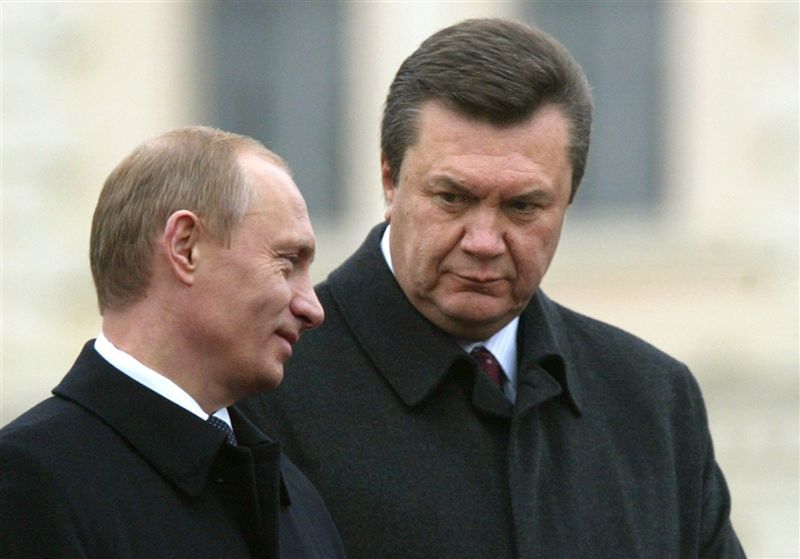
Ukraine’s Government Frantically Seeks Another Discount On Russian Gas
Publication: Eurasia Daily Monitor Volume: 8 Issue: 79
By:

Undermining their own negotiating position, Ukraine’s top leaders sound desperate for a price discount on Russian gas, and hurriedly offer pre-emptive concessions to Moscow. On April 21 President, Viktor Yanukovych, declared, “Ukraine cannot afford this [current] price. The situation is on the edge. Our industry can barely compete.” Yanukovych announced the start of efforts to negotiate a “second phase” of lowering the price of Russian gas, after the first phase embodied in the Kharkiv agreements exactly one year ago. According to Yanukovych, it would be “perfectly acceptable” to Ukraine to switch to Russian ruble accounting for gas, if Russia lowers the price (Interfax-Ukraine, UNIAN, April 21).
With similar urgency, Prime Minister, Nikolai Azarov, proclaims the goal of lowering the price of Russian gas to $200 per one thousand cubic meters (bcm), meaning a one-third cut from the present level. Azarov relentlessly describes the existing price as “enslavement of Ukraine,” blaming the former government of Yulia Tymoshenko while pleading with Russia for “fairness,” and proposing Ukrainian asset transfers in return. Azarov hopes for an even deeper discount to $170 per one thousand bcm, as agreed by Gazprom for a volume of 4 bcm delivered to Ukrainian oligarch Dmytro Firtash’s fertilizer enterprises, timed to the agricultural season. Firtash has qualified for this favor as the main Ukrainian owner of Gazprom’s joint venture in Ukraine, RosUkrEnergo (Den, April 19).
Under the Kharkiv agreements of April 21, 2010, Russia granted Ukraine a 30 percent discount on the price of gas, relative to the January 2009 agreement concluded by the Tymoshenko government. In return for the favor, Yanukovych agreed with Russian President Dmitry Medvedev to prolong the stationing of Russia’s Black Sea Fleet on Ukraine’s territory until well into the 2040’s.
That discount notwithstanding, the gas price per one thousand bcm is rebounding to levels that hurt Ukraine’s inefficient steel and chemical industries. After a fleeting drop from $306 in the first quarter of 2010 to $233 in the second quarter (an immediate result of the Kharkiv agreements), the price rose to $249 in the third quarter, $252 in the fourth, $264 in the first quarter of 2011, $295 in this year’s second quarter, and is forecast at $300 on an annualized basis in 2011. The main factor behind the upward curve is the peg of the gas price to the cost of the oil products basket. The latter’s cost surge is attributed to the Arab turmoil, among other factors (Interfax-Ukraine, April 14, 21).
Ukrainian leaders, particularly Azarov, almost beseeched Russian Prime Minister, Vladimir Putin, for another price cut when Putin visited Kyiv on April 12. Putin sternly warned Kyiv (or more to the point, Donetsk) to comply with the existing agreement fully. On that condition, Putin did not rule re-examining the gas price, and tasked Deputy Prime Minister, Igor Sechin, to do so with the Ukrainian side. The Russian government is clearly inclined to consider a further discount, in return for substantial asset transfers from Naftohaz Ukrainy to Russia. On April 19, Sechin held talks with Ukrainian First Deputy Prime Minister, Andriy Klyuyev, in Kyiv. They agreed to set up a group of experts to re-examine the gas price. Azarov asked Klyuyev and the Fuel and Energy Minister, Yuriy Boyko, publicly to “deploy all the arguments, all analyses, all their knowledge,” in order to persuade the Russian side (Interfax-Ukraine, April 12-14, 19, 20).
Rather than persuasiveness, however, Moscow expects material concessions from Ukraine in return for a second phase of lowering the gas price. Putin and other Russian officials, as well as Gazprom, are suggesting a rather wide range of quid-pro-quo options:
1. Switching to Russian ruble accounting (or in an even more radical version, ruble pricing) for Russian gas supplies to Ukraine. In his April 20 annual report to Russia’s Duma, Putin aired this idea, attributing the initiative to Ukrainian leaders themselves (ITAR-TASS, April 20). Putin’s remark implies drawing Ukraine into a would-be ruble zone and ruble-based currency union. This would reduce Ukraine to dependence on Russia’s Central Bank, which would set the currency course and rates of exchange, imposing them on Ukraine.
2. Joining the Russia-Belarus-Kazakhstan Customs Union, this should qualify Ukraine to further discounts on the price of Russian gas. This would, however, kill Ukraine’s prospect to sign an association agreement and a deep-and-comprehensive free trade agreement (DCFTA) with the European Union, which both Brussels and Kyiv plan to sign by this year’s end.
3. Forming a joint company of Gazprom and Naftohaz Ukrainy. This could take the form of a “merger” (Putin’s opening gambit); a 50 percent – 50 percent joint venture (Yanukovych’s response); Gazprom takeover of Ukrainian transit pipelines or distribution networks, under the rubric of “privatization” in Ukraine (Gazprom Vice-Chairman Valery Golubev’s proposal, RIA Novosti, April 7); or Gazprom investment in the Ukrainian transit system’s modernization, apparently in return for some form of control over it (Azarov’s suggestion, Interfax-Ukraine, April 12, 13).
Such would be Ukraine’s price to pay, if Donetsk industrialists and the government representing them fail to adapt the steel and chemical industries to the requirements of a modern economy.




